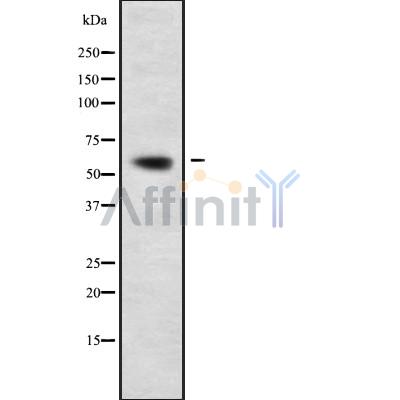AAAS Antibody - #DF9182
| Product: | AAAS Antibody |
| Catalog: | DF9182 |
| Description: | Rabbit polyclonal antibody to AAAS |
| Application: | WB IHC |
| Reactivity: | Human |
| Prediction: | Pig, Zebrafish, Bovine, Horse, Sheep, Rabbit, Dog, Chicken, Xenopus |
| Mol.Wt.: | 60 kDa; 60kD(Calculated). |
| Uniprot: | Q9NRG9 |
| RRID: | AB_2842378 |
Product Info
*The optimal dilutions should be determined by the end user.
*Tips:
WB: For western blot detection of denatured protein samples. IHC: For immunohistochemical detection of paraffin sections (IHC-p) or frozen sections (IHC-f) of tissue samples. IF/ICC: For immunofluorescence detection of cell samples. ELISA(peptide): For ELISA detection of antigenic peptide.
Cite Format: Affinity Biosciences Cat# DF9182, RRID:AB_2842378.
Fold/Unfold
AAA; AAAS; AAASb; Achalasia adrenocortical insufficiency alacrimia (Allgrove triple A); Achalasia adrenocortical insufficiency alacrimia; ADRACALA; ADRACALIN; Aladin; Allgrove triple A; DKFZp586G1624; GL003;
Immunogens
Widely expressed (PubMed:11159947, PubMed:16022285). Particularly abundant in cerebellum, corpus callosum, adrenal gland, pituitary gland, gastrointestinal structures and fetal lung (PubMed:11159947).
- Q9NRG9 AAAS_HUMAN:
- Protein BLAST With
- NCBI/
- ExPASy/
- Uniprot
MCSLGLFPPPPPRGQVTLYEHNNELVTGSSYESPPPDFRGQWINLPVLQLTKDPLKTPGRLDHGTRTAFIHHREQVWKRCINIWRDVGLFGVLNEIANSEEEVFEWVKTASGWALALCRWASSLHGSLFPHLSLRSEDLIAEFAQVTNWSSCCLRVFAWHPHTNKFAVALLDDSVRVYNASSTIVPSLKHRLQRNVASLAWKPLSASVLAVACQSCILIWTLDPTSLSTRPSSGCAQVLSHPGHTPVTSLAWAPSGGRLLSASPVDAAIRVWDVSTETCVPLPWFRGGGVTNLLWSPDGSKILATTPSAVFRVWEAQMWTCERWPTLSGRCQTGCWSPDGSRLLFTVLGEPLIYSLSFPERCGEGKGCVGGAKSATIVADLSETTIQTPDGEERLGGEAHSMVWDPSGERLAVLMKGKPRVQDGKPVILLFRTRNSPVFELLPCGIIQGEPGAQPQLITFHPSFNKGALLSVGWSTGRIAHIPLYFVNAQFPRFSPVLGRAQEPPAGGGGSIHDLPLFTETSPTSAPWDPLPGPPPVLPHSPHSHL
Predictions
Score>80(red) has high confidence and is suggested to be used for WB detection. *The prediction model is mainly based on the alignment of immunogen sequences, the results are for reference only, not as the basis of quality assurance.
High(score>80) Medium(80>score>50) Low(score<50) No confidence
PTMs - Q9NRG9 As Substrate
| Site | PTM Type | Enzyme | Source |
|---|---|---|---|
| C2 | Acetylation | Uniprot | |
| S33 | Phosphorylation | Uniprot | |
| K52 | Ubiquitination | Uniprot | |
| K56 | Ubiquitination | Uniprot | |
| T57 | Phosphorylation | Uniprot | |
| K78 | Ubiquitination | Uniprot | |
| K165 | Ubiquitination | Uniprot | |
| K189 | Ubiquitination | Uniprot | |
| S261 | Phosphorylation | Uniprot | |
| S263 | Phosphorylation | Uniprot | |
| K301 | Ubiquitination | Uniprot | |
| T306 | Phosphorylation | Uniprot | |
| T333 | Phosphorylation | Uniprot | |
| S337 | Phosphorylation | Uniprot | |
| S341 | Phosphorylation | Uniprot | |
| K373 | Ubiquitination | Uniprot | |
| K416 | Ubiquitination | Uniprot | |
| K418 | Ubiquitination | Uniprot | |
| K425 | Ubiquitination | Uniprot | |
| S495 | Phosphorylation | Uniprot | |
| S511 | Phosphorylation | Uniprot | |
| T519 | Phosphorylation | Uniprot | |
| S522 | Phosphorylation | Uniprot | |
| T524 | Phosphorylation | Uniprot | |
| S525 | Phosphorylation | Uniprot | |
| S541 | Phosphorylation | Uniprot |
Research Backgrounds
Plays a role in the normal development of the peripheral and central nervous system. Required for the correct localization of aurora kinase AURKA and the microtubule minus end-binding protein NUMA1 as well as a subset of AURKA targets which ensures proper spindle formation and timely chromosome alignment.
Nucleus>Nuclear pore complex. Cytoplasm>Cytoskeleton>Spindle pole.
Note: In metaphase cells localizes within the spindle with some accumulation around spindle poles, with the highest concentration between the centrosome and metaphase plate (PubMed:26246606). The localization to the spindle is microtubule-mediated (PubMed:26246606).
Widely expressed. Particularly abundant in cerebellum, corpus callosum, adrenal gland, pituitary gland, gastrointestinal structures and fetal lung.
Interacts with NDC1, the interaction is required for nuclear pore localization. Interacts with the inactive form aurora kinase AURKA.
Research Fields
· Genetic Information Processing > Translation > RNA transport.
Restrictive clause
Affinity Biosciences tests all products strictly. Citations are provided as a resource for additional applications that have not been validated by Affinity Biosciences. Please choose the appropriate format for each application and consult Materials and Methods sections for additional details about the use of any product in these publications.
For Research Use Only.
Not for use in diagnostic or therapeutic procedures. Not for resale. Not for distribution without written consent. Affinity Biosciences will not be held responsible for patent infringement or other violations that may occur with the use of our products. Affinity Biosciences, Affinity Biosciences Logo and all other trademarks are the property of Affinity Biosciences LTD.





